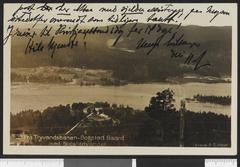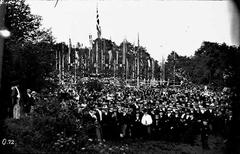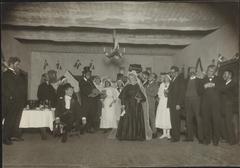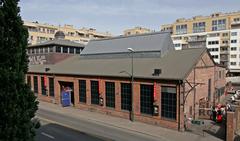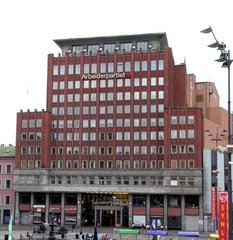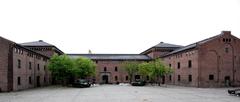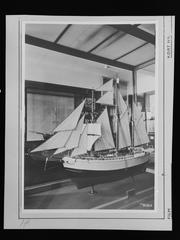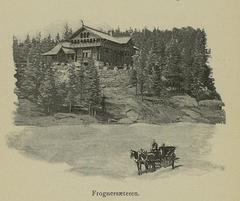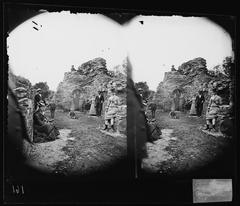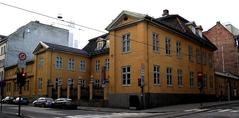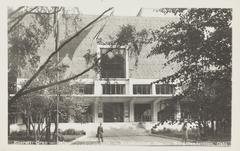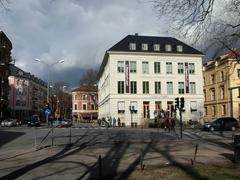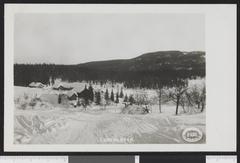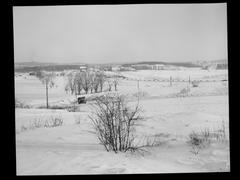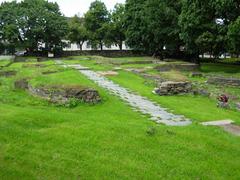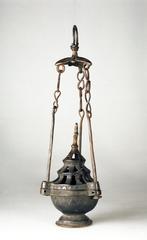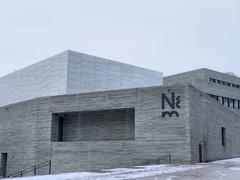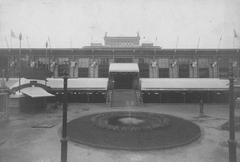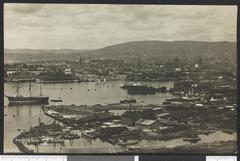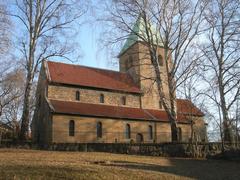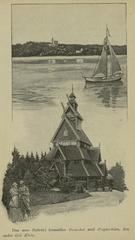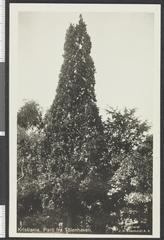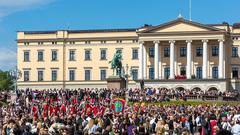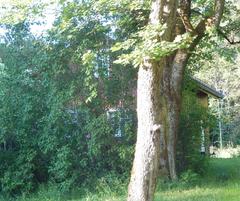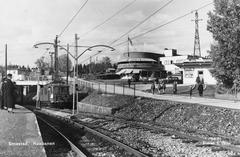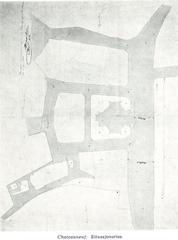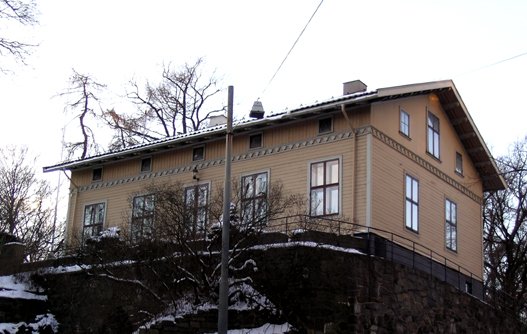
Grotten Oslo: Visiting Hours, Tickets, and Historical Significance Guide
Date: 04/07/2025
Introduction to Grotten Oslo
Nestled within the lush expanse of Slottsparken (Palace Park) at the heart of Oslo, Grotten is an emblem of Norway’s rich artistic legacy and cultural identity. As Norway’s first Swiss-style house, Grotten was originally the home of the influential 19th-century poet and reformer Henrik Wergeland. Today, it serves as a state-owned honorary residence for Norway’s most distinguished artists—a powerful symbol of the nation’s recognition and celebration of cultural excellence.
While the villa functions primarily as a private residence and is generally closed to interior tours, Grotten’s unique architecture, storied history, and picturesque setting beside the Royal Palace make it a notable destination for anyone interested in Oslo’s cultural heritage. This guide details Grotten’s origins, architectural features, notable residents, visitor logistics, and practical tips to maximize your experience in Oslo.
For official updates and further visitor information, see Visit Oslo and Store norske leksikon.
Table of Contents
- Introduction
- Origins and Architectural Significance
- Henrik Wergeland and Grotten’s Early Years
- Transition to an Honorary Residence
- Visiting Grotten: Hours, Tickets, and Tours
- Special Events and Exhibitions
- Photographic Opportunities and Visitor Tips
- Grotten’s Role in Norwegian Cultural Identity
- Grotten in the Context of Oslo’s Historical Development
- Notable Residents and Contributions
- Frequently Asked Questions (FAQ)
- Preservation and Public Engagement
- Location, Accessibility, and Visitor Logistics
- Conclusion
- References and Useful Links
Origins and Architectural Significance
Grotten is situated at the edge of Slottsparken, Oslo’s Palace Park, on a rocky outcrop. The house was designed by Henrik Wergeland in collaboration with Hans Linstow, architect of the Royal Palace. Completed in 1841, Grotten stands as Norway’s first Swiss chalet-style residence—a design marked by a harmonious integration with its natural surroundings and a romantic vision of rural living. The villa’s use of timber, wide eaves, and ornamental woodwork influenced the development of Norwegian residential architecture in the 19th century.
The property’s name, Grotten (“The Grotto”), comes from the natural ravine beneath the house, which was expanded into a stone chamber that Wergeland used as his study and cabinet of curiosities.
Henrik Wergeland and Grotten’s Early Years
Henrik Wergeland (1808–1845) was a central figure in shaping Norwegian national consciousness in the 19th century. Grotten was both his personal retreat and a vibrant gathering place for artists and intellectuals. Wergeland’s time at Grotten was marked by prolific creativity and a deep engagement with Norwegian culture and nature.
Transition to an Honorary Residence
Following Wergeland’s death, Grotten became a state-owned honorary residence (æresbolig) for Norway’s leading cultural figures. Since the 1920s, this tradition has continued under royal patronage, honoring artists who have made outstanding contributions to Norwegian arts and culture. Residents are granted use of Grotten for life, reflecting a deep national appreciation for the arts (Wikipedia).
Notable residents include composer Christian Sinding, writer Arnulf Øverland, composer Arne Nordheim, and playwright Jon Fosse. Each resident has contributed significantly to Norway’s artistic landscape (Visit Norway).
Visiting Grotten: Hours, Tickets, and Tours
- Visiting Hours: Grotten’s interior is not open to regular public tours. However, its exterior can be admired year-round from Slottsparken, which is open 24/7.
- Tickets: No tickets are needed to view Grotten’s exterior or enter the park. Occasionally, special events or Constitution Day (May 17th) may grant limited access—check with Visit Oslo or the Oslo Visitor Centre for current details.
- Guided Tours: While interior tours are rare, Grotten is frequently included as a highlight on guided walking tours of Oslo’s historic district.
- Accessibility: The house is located on a rocky rise, so the area immediately surrounding it may be challenging for those with limited mobility. Slottsparken’s primary paths are accessible and well-maintained.
Special Events and Exhibitions
Grotten occasionally opens its stone grotto chamber to the public on Norway’s Constitution Day, May 17th, honoring Wergeland’s legacy. At other times, cultural events and exhibitions may take place by special arrangement, providing rare opportunities for interior access. Information on such events is typically available through official tourism channels (Store norske leksikon).
Photographic Opportunities and Visitor Tips
- Best Views: Capture Grotten’s distinct Swiss-style facade from the park’s winding paths—spring and autumn offer especially vibrant backdrops.
- Nearby Landmarks: Combine your visit with the Royal Palace, National Theatre, and National Museum—all within easy walking distance.
- Visitor Etiquette: Respect the privacy of the current residents; maintain a respectful distance and enjoy the tranquil setting of Slottsparken.
- Facilities: Restrooms and cafés are available at the Royal Palace and along Karl Johans gate.
Grotten’s Role in Norwegian Cultural Identity
Grotten is deeply woven into Norway’s tradition of honoring creative excellence. Its status as an honorary residence for artists underscores the country’s commitment to cultural investment and the celebration of intellectual achievement. The villa’s continued use for this purpose keeps the legacy of national artistic accomplishment alive (Visit Norway).
Grotten in the Context of Oslo’s Historical Development
Built during a period of rapid urban and cultural growth in the 19th century, Grotten remains a testament to Oslo’s transformation into a modern European capital. Its proximity to the Royal Palace and integration within Slottsparken place it at the crossroads of Oslo’s civic and cultural life (Trek Zone).
Notable Residents and Contributions
- Henrik Wergeland (1808–1845): Poet, reformer, and the original resident of Grotten.
- Christian Sinding (1856–1941): Composer known for orchestral and chamber music.
- Arnulf Øverland (1889–1968): Poet and essayist, advocate for freedom of expression.
- Arne Nordheim (1931–2010): Leading figure in contemporary Norwegian music.
- Jon Fosse (b. 1959): Playwright and Nobel laureate, current resident (Wikipedia).
Frequently Asked Questions (FAQ)
Q: Can I visit inside Grotten?
A: Grotten is a private residence and not generally open for interior visits. Limited access may be available during special events.
Q: How do I get to Grotten?
A: Grotten is located at Wergelandsveien 2, next to the Royal Palace. The nearest transport hub is Nationaltheatret station (tram, metro, bus, train). It’s a short walk through Slottsparken.
Q: Are tickets required?
A: No tickets are needed to view Grotten’s exterior. Tickets may be required for special events.
Q: Is Grotten accessible for people with disabilities?
A: While Slottsparken’s primary paths are accessible, the terrain around Grotten is uneven. For assistance, contact the Oslo Visitor Centre.
Q: When can the public enter the grotto?
A: The stone chamber is usually open only on May 17th (Constitution Day) or during special events.
Preservation and Public Engagement
Grotten remains an active honorary residence, but its role in Oslo’s cultural life is enhanced through occasional public events, literary commemorations, and its inclusion on walking tours. This ongoing engagement preserves its legacy while respecting the privacy of its residents.
Location, Accessibility, and Visitor Logistics
Address: Wergelandsveien 2 (sometimes listed as Wergelandsveien 4), 0167 Oslo, Norway
Transport:
- Tram/Metro/Bus/Train: Nationaltheatret station
- Walking: 5–10 minutes through Slottsparken
- Cycling: Oslo City Bike stations nearby
- Parking: Limited; public transport is recommended
Accessibility:
- Slottsparken’s main paths are wheelchair-friendly; Grotten’s immediate area is less accessible due to its hillside setting.
Facilities Near Grotten:
- Restrooms in Slottsparken and Nationaltheatret station
- Cafés and restaurants along Karl Johans gate
- Maps and visitor information at the Oslo Visitor Centre
Conclusion
Grotten is a living symbol of Norway’s respect for artistic achievement—a tranquil yet powerful presence in Oslo’s cultural heart. While access to the interior is limited, the villa’s elegant exterior, storied history, and peaceful park setting make it a rewarding stop for anyone exploring Oslo’s past and present. For special opening times, event updates, and accessibility information, consult Visit Oslo and the Oslo Visitor Centre.
Take time to appreciate Grotten’s unique story as part of Oslo’s remarkable cultural landscape, and consider planning your visit around Constitution Day or special cultural events for a deeper experience.
References and Useful Links
- Visit Oslo
- Wikipedia: Grotten
- Store norske leksikon: Grotten
- Visit Norway: Famous Writers
- Trek Zone: Grotten
- Oslo Visitor Centre
- Official Royal Palace Website
- Tourist Places Guide
- Girl with the Passport: Norway Travel Guide
Image Recommendations:
Include high-quality images of Grotten’s exterior with descriptive alt text such as “Grotten Oslo Swiss-style house exterior view.” Maps highlighting Grotten’s location within Slottsparken can further enhance visitor engagement.
Explore More:
Stay Connected:
Download the Audiala mobile app for curated cultural experiences, updates on Oslo’s historical sites, and visitor tips.



